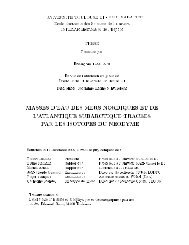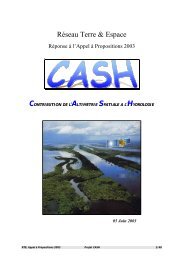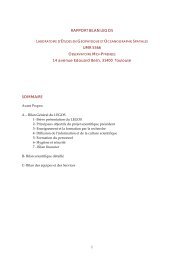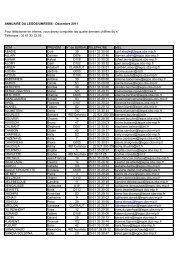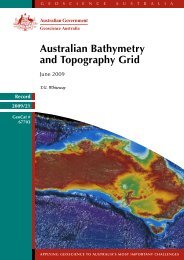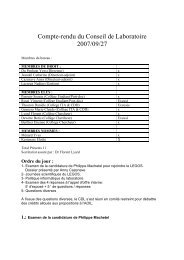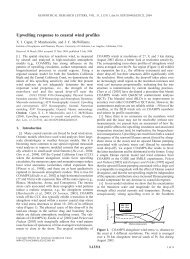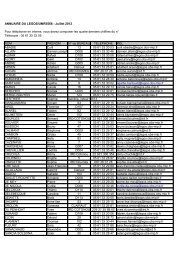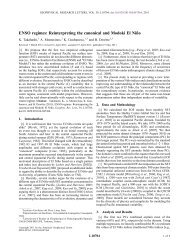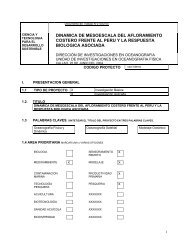Chaigneau and Pizarro - LEGOS
Chaigneau and Pizarro - LEGOS
Chaigneau and Pizarro - LEGOS
You also want an ePaper? Increase the reach of your titles
YUMPU automatically turns print PDFs into web optimized ePapers that Google loves.
C05014 CHAIGNEAU AND PIZARRO: CIRCULATION OF THE EASTERN SOUTH PACIFIC<br />
observations during this season (295 compared to 350–<br />
420), but also to the slight decrease of zonal wind stress<br />
intensity in the SEC region during the summer period (not<br />
shown). The velocity variance is quasi isotropic ( 90 cm 2<br />
s 2 ) with slightly higher variance along the zonal direction<br />
(u 0 2 /v 0 2 = 1.1). In contrast, the southwestern box related to<br />
the SPC shows strong seasonal variability with an eastward<br />
flow of 3–4 cm s 1 in fall (April to June) <strong>and</strong> winter<br />
(July to September), which decreases to 1 cm s 1 in<br />
spring (October to December) <strong>and</strong> reverses to a westward<br />
flow of 1cms 1 in summer. Even if the reversed current<br />
of 1cms 1 is not statistically significant <strong>and</strong> is on the<br />
order of the error (Table 1), a plot of the seasonal<br />
variability of the surface circulation (not shown) suggests<br />
meridional displacement of the southern limit of the SEC,<br />
with the westward current appearing between 30°S <strong>and</strong><br />
32°S during spring <strong>and</strong> summer, <strong>and</strong> between 26°S <strong>and</strong><br />
28°S in fall <strong>and</strong> winter. These oceanic seasonal variations<br />
are directly linked to the annual meridional displacement<br />
of the atmospheric high-pressure center of the eastern<br />
South Pacific, which migrates to the north during fall<br />
<strong>and</strong> winter. The seasonal wind stress calculated with the<br />
ERS data (not shown) in the same domain (30°S–34°S<br />
<strong>and</strong> 86°W–100°W) shows stronger magnitudes in fall <strong>and</strong><br />
winter (0.1 N m 2 ) than in spring <strong>and</strong> summer (0.05 N m 2 ).<br />
The SPC is anisotropic, with a 20–40% higher velocity<br />
variance along the zonal direction. The Chile-Peru Current<br />
shows a strong northward component, which is maximum in<br />
spring <strong>and</strong> minimum in fall. Again, this may be related to the<br />
wind regime because the satellite ERS measurements<br />
indicate stronger northward winds in this region between<br />
winter <strong>and</strong> summer (0.05–0.06 N m 2 ) than during fall<br />
(0.035 N m 2 ). On average, the CPC seems to be totally<br />
isotropic with a similar velocity variance of 110 cm 2 s 2<br />
in both zonal <strong>and</strong> meridional directions. On a seasonal<br />
scale, the data reveal strong anisotropy, for example,<br />
zonal variance is 70% stronger than its meridional counterpart<br />
in fall. This anisotropy could be linked to the<br />
Ekman transport, which indicates a zonal variance around<br />
250% stronger than the meridional variance during this<br />
season (not shown).<br />
[16] The quantification of the surface eddy momentum<br />
flux (u 0 v 0 ) is important for underst<strong>and</strong>ing how eddies may<br />
act to transport momentum into or away from the mean flow<br />
[Morrow et al., 1992]. In the first place, the SEC <strong>and</strong> SPC<br />
can be considered to be zonal <strong>and</strong> the CPC meridional. In<br />
this case, the cross stream flux of along-stream momentum<br />
by transient eddies is given by u 0 v 0 [Wilkin <strong>and</strong> Morrow,<br />
1994; Morrow et al., 1992, 1994]. For the westward SEC<br />
<strong>and</strong> eastward SPC, this term represents the meridional<br />
transfer of the zonal momentum, whereas for the equatorward<br />
CPC, it corresponds to the zonal transfer of meridional<br />
momentum. Owing to the mean westward (eastward, respectively)<br />
SEC (SPC), positive (negative) values of horizontal<br />
momentum flux (Table 1) correspond to a southward<br />
transport of the zonal momentum. The eddy flux momentum<br />
associated to the equatorward CPC is negative, with<br />
maximum values of around 25 cm 2 s 2 in austral winter<br />
<strong>and</strong> spring, revealing a westward transfer of the meridional<br />
momentum.<br />
[17] Table 1 also shows that the velocities obtained using<br />
the climatology <strong>and</strong> satellite wind data (WOA+ERS) un-<br />
6of17<br />
derestimate the South-Equatorial <strong>and</strong> Chile-Peru Currents<br />
<strong>and</strong> overestimate the South-Pacific Current. However, the<br />
directions of the SEC <strong>and</strong> SPC are well reproduced. In<br />
contrast, the intensity of the CPC is more than 2 times lower<br />
in the calculated velocities <strong>and</strong> the direction indicates a<br />
northward flow rather than an observed northwest current.<br />
These discrepancies may be induced by different factors,<br />
such as the coarse spatiotemporal resolution of the WOA<br />
climatology, or the Ekman velocity estimates, which are<br />
clearly underestimated in the northern part of the study<br />
region.<br />
3.2. Variance Ellipses<br />
[18] Velocity variance statistics were calculated from the<br />
drifter velocity components in each cell grid. From these<br />
data, we can compute the velocity variance terms (u0 2 , v0 2 )<br />
<strong>and</strong> the covariance term (u0v0 ). Following the method used<br />
first by Freel<strong>and</strong> et al. [1975] in the North Atlantic ocean,<br />
the magnitude <strong>and</strong> the direction of the eddy variability are<br />
represented using variance ellipses [Preisendorfer, 1988;<br />
Morrow et al., 1992, 1994]. The formula giving the major<br />
<strong>and</strong> minor axes of principal variability can be found in<br />
Morrow et al. [1994] <strong>and</strong> Le Traon <strong>and</strong> Morrow [2001].<br />
The direction of eddy momentum flux can be inferred from<br />
the ellipse orientation: negative u0v0 correspond to ellipses<br />
oriented southeastward, whereas ellipses oriented toward<br />
the northeast quadrant have positive u0v0 [Le Traon <strong>and</strong><br />
Morrow, 2001].<br />
[19] Velocity variance ellipses reveal the principal direction<br />
<strong>and</strong> anisotropic nature of the variability, as well as the<br />
magnitude <strong>and</strong> spatial distribution of the eddy energy.<br />
Figure 3 confirms the previous results that the flow tends<br />
to be nonisotropic in the most part of the domain <strong>and</strong> overall<br />
along the coast where the eddy kinetic energy is higher<br />
[Hormazabal et al., 2004]. In the SEC (SPC, relatively)<br />
region, the ellipses are oriented to the northeast (southeast),<br />
in agreement with the positive (negative) eddy momentum<br />
fluxes u0v0 (Table 1). The southeast orientation of the<br />
ellipses in the CPC region also confirms the negative values<br />
of u0v0 shown in Table 1.<br />
3.3. Eddy Kinetic Energy<br />
[20] The mean eddy kinetic energy per unit of mass is<br />
calculated in each bin from the drifter data using<br />
EKE ¼ 1<br />
ð 0 2Þ;<br />
2 u0 2 þ v<br />
C05014<br />
where the overbar denotes time average.<br />
[21] The EKE is, on average, weaker in the SEC region<br />
defined in Table 1 (87.7 cm 2 s 2 ) than in the SPC region<br />
(103 cm 2 s 2 ) <strong>and</strong> CPC region (112.7 cm 2 s 2 ). The<br />
mean kinetic energy (MKE = 1/2(U 2 + V 2 )) is 2–3 times<br />
smaller than the EKE in the SPC <strong>and</strong> CPC (35.9 cm 2 s 2<br />
<strong>and</strong> 44.9 cm 2 s 2 ) <strong>and</strong> negligible in the SEC region<br />
(4.1 cm 2 s 2 ).<br />
[22] Despite the nonuniform character of the data,<br />
Figure 4a shows a decrease in EKE values from 200–<br />
300 cm 2 s 2 along the continental coast to 50–100 cm 2 s 2 in<br />
the interior ocean. We also note the presence of a<br />
local maximum of around 140 cm 2 s 2 in the southwest<br />
boundary of the domain linked to the seasonal meridional





